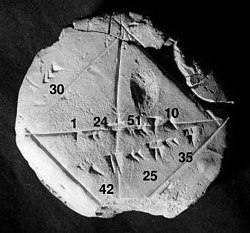Numerical analysis
It is the study of numerical methods that attempt to find approximate solutions of problems rather than the exact ones.Current growth in computing power has enabled the use of more complex numerical analysis, providing detailed and realistic mathematical models in science and engineering.Examples of numerical analysis include: ordinary differential equations as found in celestial mechanics (predicting the motions of planets, stars and galaxies), numerical linear algebra in data analysis,[2][3][4] and stochastic differential equations and Markov chains for simulating living cells in medicine and biology.Before modern computers, numerical methods often relied on hand interpolation formulas, using data from large printed tables.Since the mid 20th century, computers calculate the required functions instead, but many of the same formulas continue to be used in software algorithms.Numerical analysis continues this long tradition: rather than giving exact symbolic answers translated into digits and applicable only to real-world measurements, approximate solutions within specified error bounds are used.[7] To facilitate computations by hand, large books were produced with formulas and tables of data such as interpolation points and function coefficients.The canonical work in the field is the NIST publication edited by Abramowitz and Stegun, a 1000-plus page book of a very large number of commonly used formulas and functions and their values at many points.But the invention of the computer also influenced the field of numerical analysis,[5] since now longer and more complicated calculations could be done.The Leslie Fox Prize for Numerical Analysis was initiated in 1985 by the Institute of Mathematics and its Applications.Starting from an initial guess, iterative methods form successive approximations that converge to the exact solution only in the limit.A convergence test, often involving the residual, is specified in order to decide when a sufficiently accurate solution has (hopefully) been found.Even using infinite precision arithmetic these methods would not reach the solution within a finite number of steps (in general).Round-off errors arise because it is impossible to represent all real numbers exactly on a machine with finite memory (which is what all practical digital computers are).An art of numerical analysis is to find a stable algorithm for solving a well-posed mathematical problem.Differential equation: If 100 fans are set up to blow air from one end of the room to the other and then a feather is dropped into the wind, what happens?The Netlib repository contains various collections of software routines for numerical problems, mostly in Fortran and C. Commercial products implementing many different numerical algorithms include the IMSL and NAG libraries; a free-software alternative is the GNU Scientific Library.The Naval Surface Warfare Center several times published its Library of Mathematics Subroutines (code here).There are also programming languages such as R[35] (similar to S-PLUS), Julia,[36] and Python with libraries such as NumPy, SciPy[37][38][39] and SymPy.[40][41] Many computer algebra systems such as Mathematica also benefit from the availability of arbitrary-precision arithmetic which can provide more accurate results.Excel, for example, has hundreds of available functions, including for matrices, which may be used in conjunction with its built in "solver".




YBC 7289square root of 2sexagesimaldecimalalgorithmsapproximationsymbolic manipulationsmathematical analysisdiscrete mathematicsordinary differential equationscelestial mechanicsnumerical linear algebrastochastic differential equationsMarkov chainsnumerical methodsinterpolationYale Babylonian Collectiondiagonalunit squarenumerical weather predictionpartial differential equationsquantitative financestocksderivativesoperations researchactuarialLinear interpolationNewton's methodLagrange interpolation polynomialGaussian eliminationEuler's methodJohn von NeumannHerman GoldstineE. T. WhittakerAbramowitz and Stegunmechanical calculatorLeslie Fox Prize for Numerical AnalysisInstitute of Mathematics and its Applicationsinfinite precision arithmeticQR factorizationsystems of linear equationssimplex methodlinear programmingfinite precisionstabilityiterative methodsconvergethe residualbisection methodJacobi iterationconjugate gradient methoddiscretizationdifferential equationfunctioncontinuumError propagationRound-off errorsreal numbersdigital computersTruncation errorsdiscretization errornumerically stablewell-conditionedgross domestic productlemonade standEuler methodHorner schemefloating-point arithmeticExtrapolationRegressionleast squaresmatrix decompositionLU decompositionCholesky decompositionsymmetrichermitianpositive-definite matrixQR decompositionJacobi methodGauss–Seidel methodsuccessive over-relaxationmatrix splittingRoot-finding algorithmsdifferentiableLinearizationeigenvalue decompositionssingular value decompositionsspectral image compressionprincipal component analysisMathematical optimizationconstraintsobjective functionLagrange multipliersNumerical integrationquadratureintegralNewton–Cotes formulasSimpson's ruleGaussian quadratureMonte Carloquasi-Monte Carlo methodsMonte Carlo integrationsparse gridsNumerical ordinary differential equationsNumerical partial differential equationsdifferential equationsfinite element methodfinite differencefinite volume methodfunctional analysisList of numerical-analysis softwareComparison of numerical-analysis softwareNetlibFortranfree-softwareGNU Scientific LibraryRoyal Statistical SocietyApplied StatisticsTransactions on Mathematical SoftwareNaval Surface Warfare CenterMATLABTK SolverS-PLUSFreeMatScilabGNU Octave